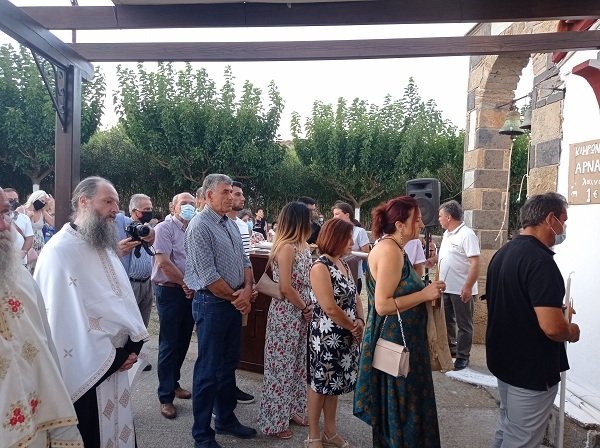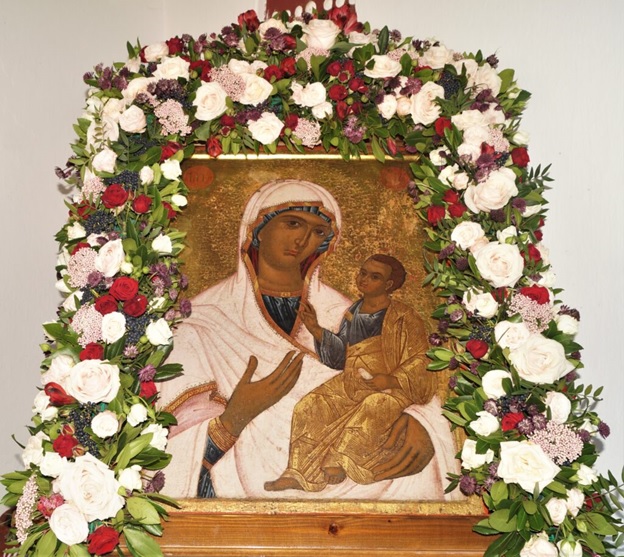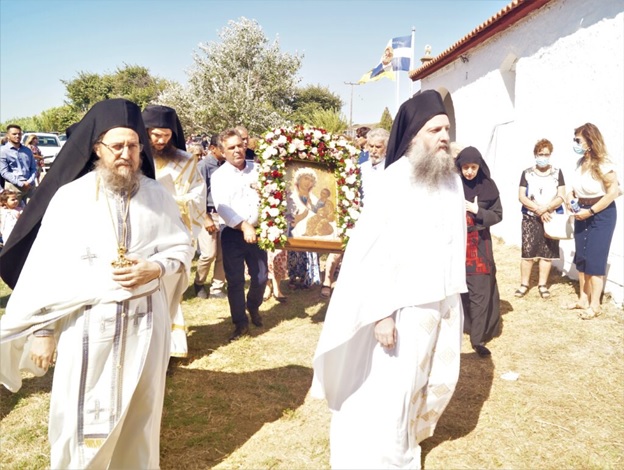Sister Parakliti, Holy Skete of Saint Mary Magdalene, in Liti
This year, God again permitted us to celebrate the Dormition of the Mother of God at her dependency of Our Lady of the Vintage. This is on the island of Limnos and belongs to the Holy Monastery of Simonos Petras, on the Holy Mountain. Once again we enjoyed the warm climate with its distinctive, quiet atmosphere when we went out to meet and to accompany back into the courtyard of the dependency the Lady of Limnos, the bride in her white raiment. When you see her, you immediately want to sing ‘Pure Virgin Maiden’ or ‘Rejoice Bride Unwedded’.
At the moment of the arrival of the icon of Our Lady, one’s heart is transferred spiritually, but firmly and in confidence, to Our Lady Mother, without the slightest hesitation. We’re all of us in need of a strong mother, a pure mother, a most holy and most healthy mother who gave birth to God.
What does healthy and holy mother mean? I’d like to devote a little time here to the purity as well as to the health of Our Lady in spirit and soul.

The purity of Our Lady isn’t solely of the body. It also extends to other dimensions of her being: the purity of her soul, the purity of her thoughts, the purity of her actions and behavior, the purity of her heart and the purity of her emotions.
I shan’t speak of the purity of her body, because we’re already well aware of it from God’s revelation and from the teaching of the Fathers of the Church.
As regards the purity of her soul, little Mary entered the holy of holies in God’s temple at the age of three. This was where she grew up, where she built the first foundations of her soul. Concerning the upbringing of a child, Saint John Chrysostom and Saint Basil the Great teach that the first seven years are the most important, and that the child should grow up in a healthy environment, with love, acceptance, security and within a firm embrace, and with boundaries, for their edification. Modern educators and psychologists agree with this. Our Lady experienced all of this in God’s temple. When children grow up in God’s temple, with the support of their parents, they’ll emerge healthy, without having been wounded or abused. They receive staunch and ever-present love from their parents, or from their guardians in the event that they’ve lost their parents. In this way children acquire firm foundations for the whole of the rest of their life. Where and how we bring our children up is our choice and decision. The pure Virgin entered the temple and remained there for many years. She left as a personality, a holy person, a healthy person, ‘all-healthy’, we might say.
The overall health of her soul and spirit is apparent in all the events mentioned in the New Testament. We recognize the healthy state of her soul and spirit in all her reactions.

Over time, this health of the soul was transformed from ‘all-healthy’ to ‘all-holy’, when she welcomed and held Christ within herself for nine months. We know few details about the years after the Nativity, about Christ’s growth as a young man, about how he matured in human terms. Mary had lost her parents while she was still young. When she gave birth to Christ, she was alone and had learned to live independently of material goods and of people. She did depend on one thing, though, the only dependence that is healthy: she depended on God. She probably raised Christ in the same way as she herself had been brought up. She nourished him in full awareness of her limits as a mother who was working with God for the good of her child. She knew she couldn’t protect him better than God did, because the boy belonged to God and would return to God. So, knowing her limitations, she accepted his mission. She supported him whenever necessary. She felt pain, but she knew, with her healthy eyes and healthy heart that she was a mother/assistant. That her child, like every other child, was a gift from God. We work with God to bring them up, because otherwise we don’t know what person will emerge when they reach maturity.
Regarding the purity of the Mother of God’s thoughts, we might wonder whether Our Lady ever had a negative attitude. She did, but didn’t hide it. She immediately asked the angel how she would bear a child, since she was a virgin. Even her pure heart wasn’t able to cleanse her mind of negativity straight away. But the soul which had learned to be pure was unable to endure the slightest wicked thought. We’re not dealing here with an obsessive compulsion or mania but with a steady state of purity. She didn’t allow negative thoughts to grow and send out other roots or to be transformed into immature actions or patterns of behaviors. After she’d opened her soul to the angel, she believed him, trusted him, didn’t give the matter another thought and went about the task of being obedient.
As regards the purity of her emotions, do we believe that Our Lady didn’t feel pain? She didn’t feel joy? She never worried? She had no feelings? Of course she did. But she never allowed an emotion to guide her without coming to an agreement with it that there would be limits. We see this very clearly at the Crucifixion of Christ, her Son. She was in pain, she was dying inside from her sorrow, but she remained close to him, surrendering the whole of her will to God. She know what was happening to her, she was aware of her emotion and that it was genuine, but she didn’t allow it to drive her. The health of her soul and spirit gave her spiritual antibodies so that she was able to remain steadfast, in the face of the death of her son, without losing her trust, without becoming hard, without indulging in her grief, without ceasing to live, without wallowing in interminable, pathological wailing. The last is particularly important because when a spiritual and psychological state ceases to mature or when, from the outset, it doesn’t have healthy foundations, then the end result will be completely wrong and the condition will become pathological.

Concerning the purity of her heart, what a heart Our Lady had and continues to have. How pure and white a heart. She had a heart that was and is at the center of her, because, as Christ says, everything proceeds from the heart. In the heart, Our Lady was completely healthy and pure. Like a living factory producing joy, obedience, patience, faith, pure air, pure breaths, pure maternal attitudes, and pure deeds. We venerate this heart and entreat that we, too, may have a place in it. We pray that she will have our skete somewhere in a corner, that she’ll intercede for all of us to have the courage to seek out and labor towards the health of our soul and spirit. That we may bring up our children in a healthy manner, as she was raised.
As the mother of God, she was always humble, always inconspicuous. She wasn’t spiritually sick, so she didn’t seek authority, nor did she hide any such passion in an unhealthy, supposedly spiritual way. As the mother of God, she didn’t seek any recognition; she was interested only in serving God and being obedient to him. And so, as we see in the icon of the Dormition, at her death God himself came to receive her, in an atmosphere of extreme veneration and true solemnity.
We wish many years, with maternal consolation, to all our brothers and sisters everywhere who are in pain. To all those suffering from distressing events: forest fires, accidents, illnesses and anything else that’s happening in this present time.
From the dependency of Our Lady of the Vintage we pray that through her intercessions, God will send messages of light to every heart and every soul. May it be a maternal and paternal message that we’re not alone is this painful life. Suffice it that we should hasten to, should wish to dwell and mature in the Temple of God, be healed in soul and spirit. Amen.
Source: pemptousia.com



0 Comments